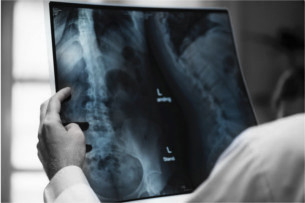STEVENS-JOHNSON SYNDROME/ TOXIC EPIDERMAL NECROLYSIS – A RARE BUT POTENTIALLY FATAL DISEASE SPECTRUM
What is Stevens-Johnson Syndrome (SJS/TEN)?
Stevens-Johnson Syndrome/Toxic Epidermal Necrolysis (SJS/TEN) is a rare, but potentially fatal severe skin condition that causes a rash on the outer-most layer of the skin and eventually skin detachment. SJS and TEN were once thought to be separate conditions but are now considered part of a disease spectrum. SJS is the less severe end of the spectrum, while TEN is the more severe end of the spectrum. SJS is when skin detachment involves less than 10% of the body surface. TEN is when skin detachment involves more than 30% of the body surface. People with 10-30% of the body surface affected are said to have “SJS/TEN overlap.” People most often get SJS/TEN from a reaction to medicine. A patient’s survival depends of the severity of the condition, the patient’s personal medical history, and how soon the condition is diagnosed and treated. Often, people with SJS/TEN initially have flu-like symptoms that then progress to painful rashes and blistering of the skin. SJS/TEN can affect people of all ages.
Mortality rates for SJS/TEN are between 1-5% if less than 10% of the body surface area is affected, and between 25-35% if more than 30% of the body surface area is affected.
Medications which can cause Stevens-Johnson Syndrome
Since SJS/TEN typically starts with an adverse reaction to medicine, it is important to know whether the medicines you are taking have the potential to cause SJS/TEN. Here is a list of the most common medicines that cause symptoms of SJS/TEN:
- Anti-gout (a type of arthritis) medications such as allopurinol.
- Anti-seizure medications such as Tegretol and Dilantin. There is additional risk for those in radiation therapy who are taking these kinds of medications.
- Lamictal (lamotrigine), which is sometimes prescribed for seizure prevention and sometimes prescribed for bipolar depression.
- NSAID (non-steroidal anti-inflammatory drugs) such as ibuprofen, Aleve, Celebrex, Bextra. Yes, that is correct, even ibuprofen and Aleve – it’s in the very small writing on the bottle.
- Pain relief medication: Tylenol and Excedrin. Yep, even these common drugs can trigger this potentially fatal reaction – read the very small print, it’s there.
- Antibiotics: The list includes Levaquin, Penicillin, and Sulfa drugs.
- Methotrexate
- Sedatives
Infectious Causes of Stevens-Johnson Syndrome
While the most common way to contract SJS/TEN is through medicine, you can also get it from an infection. So, if you have any of these infections, be on the lookout for rashes, too: Herpes virus (herpes simplex or herpes zoster), Pneumonia, HIV, and Hepatitis A.
Risk Factors for Developing Stevens-Johnson Syndrome:
- SJS/TEN plays favorites. Not everyone is equally likely to develop this disease.
- The incidence of Stevens-Johnson Syndrome in people with HIV infection is 100 times greater than the rest of the population.
- A weakened immune system, which can be caused by having undergone an organ transplant and being on rejection medications or having other autoimmune diseases.
- If one has had a medication-related onset of Stevens-Johnson Syndrome, there is an increased risk if this same medication is again used.
- Family history of Stevens-Johnson Syndrome or Toxic Epidermal Necrolysis.
- Having the gene HLA-B*1502. This gene puts one at increased risk of developing Stevens-Johnson Syndrome, particularly if drugs for seizures, mental illness, or gout are taken. This gene is more likely to be found in people of Chinese, Southeast Asian, or Indian descent.
Complications from Stevens-Johnson Syndrome
While we often think of reactions to medicine as being treatable or benign, the complications from SJS/TEN can be very serious if not treated properly and timely. Cellulitis, which is a skin infection, can develop in people with SJS/TEN. This can lead to sepsis, which is a life-threatening complication. Sepsis occurs when the skin infection enters the blood stream. Sepsis can cause organ failure secondary to shock, which decreases blood flow to the vital organs of the body. Another complication from SJS/TEN is eye inflammation. This can be mild and result in irritation or dry eyes, or it can lead to extensive tissue damage and scarring, resulting in serious visual impairment or blindness. Acute respiratory failure can also be caused by SJS/TEN. Other complications include permanent skin damage and scarring and vaginal stenosis (narrowing). Finally, in severe cases, the patient can die from the effects of contracting SJS/TEN.
Prevention of SJS/TEN
Preventive measures are important to keep in mind because so many medications can cause SJS/TEN. Preventive measures include genetic testing prior to taking certain drugs if one is of Chinese, Southeast Asian, or Indian descent. If one has previously had this condition, they should avoid the medication that triggered it (no brainer here). When taking NSAIDs or pain medications, start with a lower dose and increase slowly while watching for flu-like symptoms, skin rash, and redness. And most importantly, if you develop a rash while taking medicine, contact your doctor right away. If the skin starts to blister, or you develop sores in your mouth, get medical help immediately. If you doctor isn’t available, get to an emergency department.
Treatment of SJS/TEN
The good news is that patients with SJS/TEN can make a full recovery, if the condition is caught and treated quickly and properly. However, if not caught quickly and treated properly, SJS/TEN can be very painful and deadly. Patients with SJS/TEN should be treated in an ICU or in a burn unit, because the effect on the skin in SJS/TEN is similar to that caused by severe burns.
The first step in treatment is to immediately stop the medication that triggered the condition. This, of course, depends upon the rapid recognition of the connection between the initial rash and the medication.
Other treatments include:
- Fluid replacement – skin loss is like a burn injury and often results in significant loss of fluid from the body. Replacement of fluids is imperative.
- Nutrition – Nutrients high in protein are essential for healing. While hospitalized, nutrition may need to be delivered through a tube going down the nose into the stomach.
- Wound Care. Dressings may need to changed regularly, and skin grafts may be necessary.
- Eye care – the services of an ophthalmologist may be required.
- Pain medication, as this can be a very painful condition.
- Medications to decrease inflammation in the eyes. Typically, eye drops with steroids are used.
- Medications to decrease inflammation of the mucous membranes. Typically, topical steroids are used. When inflammation affects the vagina, a dilator may be needed to prevent vaginal narrowing.
- Administration of antibiotics to treat infection/sepsis.
- Other types of treatment may be required in the presence of life-threatening forms of this condition and would be decided on case by case basis.
Sometimes SJS/TEN is the Result of Medical Negligence
Unfortunately, sometimes patients develop SJS/TEN as a result of medical negligence. This can happen when a medication known to trigger SJS/TEN is prescribed in inappropriate circumstances or in inappropriate amounts. In other cases, patients who develop SJS/TEN suffer significant injury because they are not diagnosed quickly, and proper treatment is not instituted or is delayed. In one common scenario, a patient on a medication known to cause SJS/TEN presents to a medical provider with a significant rash, but the provider fails to consider the possibility of SJS/TEN. As a result, the patient returns home and takes the offending medication again. Then, the condition gets much, much worse.
The Eisen Law Firm recently litigated and resolved a very tragic death case involving a teenager who died from complications of Stevens-Johnson Syndrome and Toxic Epidermal Necrolysis. When a serious injury is caused by medical error, you need an experienced Medical Malpractice team fighting on your behalf. If you or a loved have suffered injury or death due to Stevens-Johnson Syndrome, Toxic Epidermal Necrolysis, or any other medication-related injury, contact Cleveland’s experienced medical malpractice attorneys at The Eisen Law Firm for a free consultation today at 216-687-0900, or contact us online.
Works Cited
Stevens-Johnson syndrome/toxic epidermal necrolysis . (2018, October 18). Retrieved from National Institutes of Health: https://rarediseases.info.nih.gov/diseases/7700/stevens-johnson-syndrometoxic-epidermal-necrolysis.
Schedule a free initial consultation with an experienced medical malpractice attorney in Cleveland to discuss the improper treatment of an aneurysm you or a loved one suffered
Our sympathies go out to the loved ones that suffer through the aftermath of suddenly losing a loved one from an aneurysm. It is even harder for families to learn that their loved one did not have to die were it not for the negligence of the physician or hospital they trusted. The Eisen Law Firm personal injury attorneys uncover the truth about whether medical malpractice occurred. We fight to recover compensation for victims and families. Call us today at 216-687-0900 or to schedule a free consultation.




